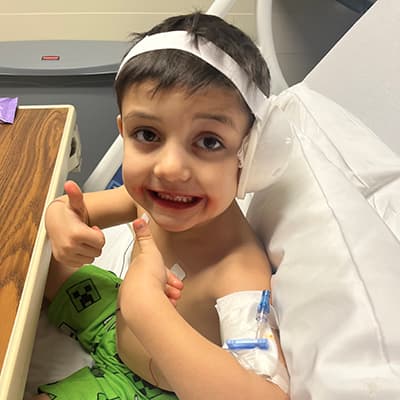Ruptured Eardrum: Dawson’s Story
Meet Dawson

Dawson’s mom Brittany was no stranger to signs of an ear infection — her poor kid had battled a dozen of them before he was 1 year old. But when his ear seemingly exploded with fluid shortly after his 4th birthday, she knew this was something different.
“Our pediatrician could tell that his eardrum had ruptured, so he sent us to Children’s Mercy,” Brittany recalled. There, they met with their team at the Ear, Nose and Throat (ENT) Clinic to come up with a plan.
Brittany and Dawson are very familiar with the halls of the Children’s Mercy Adele Hall Campus. During Dawson’s first 4 years of life, “we practically lived at Children’s Mercy,” Brittany said. “I joked with the nurses that they should name a wing after us!”
In addition to frequent ear infections, Dawson had ear tubes placed when he was 19 months old and his tonsils and adenoids removed just before he turned 3. All these procedures meant frequent visits to the ENT Clinic and many, many rounds of antibiotics.
Tobie O’Brien, RN, APRN, CPNP, often cared for Dawson on his visits to the ENT Clinic. “Tobie is amazing — I adore her!” said Brittany. “I love the way she talks to parents. She’s never condescending and always reassures me.”
Tobie explained why some kids struggle with ear infections:
“Young children get recurrent ear infections mainly because their eustachian tube (the tube that connects the middle ear to the back of nose) is shorter, more horizontal and less efficient than an adult’s. When kids get common colds, mucus can travel from the back of the nose into the middle ear space, and that trapped fluid can become infected.

Ear infections in young kids are often treated with oral antibiotics. For kids that get ear infections recurrently, like Dawson, we recommend ear tubes. Ear tubes help bypass the immature eustachian tubes and create a tiny ventilation system for the middle ear. With most kids, the tubes fall out on their own, and the ear drum heals. However, there is a small risk (around 1 to 3%) that when the tube comes out, there could be a hole remaining in the eardrum.”
At first, the ENT team tried using a temporary paper patch on Dawson's ruptured eardrum. Unfortunately, the patch didn’t stay in place, and Dawson continued to have drainage and ear infections. He couldn’t swim or get water in his ears, and he had lost significant hearing in his left ear — so much so that he needed a hearing aid. It was time for a new approach.
Brittany and Dawson met with Michael Puricelli, MD, an ENT surgeon who had just joined the Children’s Mercy ENT team a few months earlier as the Director of the Comprehensive Otology and Hearing Program.
Dr. Puricelli is passionate about his work: “ENT is a fantastic discipline. We treat a wide variety of patient concerns, perform technical procedures on intricate anatomy and often get to enjoy the great outcomes through sustained relationships with our patients.”
At first, Brittany struggled to trust that things would turn out all right with Dawson: “At the beginning I was really frustrated, and it was hard to feel like we weren’t getting answers. But looking back, I'm so grateful for the staff that is there. Everyone's really friendly and nice. Dr. Puricelli and his team are just incredible.”
Dr. Puricelli discovered that Dawson had developed an additional complication. “Dawson had cholesteatoma, a benign growth of skin inside the ear that can eat away at the bone if left untreated,” he explained. “He underwent hearing testing and a microscopic examination of the ear in the office with photos. This allowed me to plan a surgery that would keep his ear safe by removing the cholesteatoma, resolve his chronic infection and drainage, waterproof the ear, and help with his hearing.”
Dr. Puricelli’s team used a small flap of skin from behind Dawson’s ear to create a patch for his ruptured eardrum, a procedure called a tympanoplasty. Dawson was younger than most kids who undergo this procedure. Since ears don’t stop growing until kids are 7 or 8, and patients have to be able to tolerate the ear cleaning aftercare, which is harder for little ones. But “Dawson was really cooperative,” Tobie recalled. “At all his post-op appointments, everything looked great!”

Brittany was incredibly relieved that her active, curious little boy could finally enjoy life without the pain and frustration of constant ear infections. “Dawson is so funny; he's the class clown!” she shared. “He lives to make everybody laugh. I’m amazed that he has this personality with everything he’s been through. I wish I was that resilient!”
Like most kids, Dawson doesn't love going to the hospital. But the blue wagons, the train by the same-day surgery lobby and seeing his ENT team are the Children’s Mercy magic that help him crack a smile at his visits.
Dawson will need continued check-ups to make sure his cholesteatoma doesn’t regrow, but “he’s doing great right now!” shared Dr. Puricelli. “His family is so committed to his medical treatment. They are willing to do whatever it takes to get the best for him.”
Brittany is grateful that they can spend more time at Dawson’s football and baseball games and reading the Patrick Mahomes books that he brings home from the library every week. “He recently had a hearing screening at school, and his hearing was perfect!”